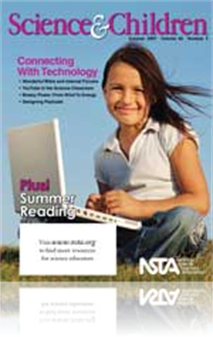All Science and Children resources
Journal Article
Science Shorts: Larger Than Life—Introducing Magnifiers
Even simple technologies can provide important support for the inquiry process. Hand lenses and other magnifiers are ubiquitous technologies in the science classroom. In the following activity, children learn how to use a simple hand lens. They draw ...
Journal Article
Perspectives: Finding a Place for Girls in Science
Because teacher expectations and classroom interactions often favor boys in science, teachers need to consider strategies to create gender-inclusive science classrooms, as suggested by researchers Brotman and Moore (2008) and Jones, Howe, and Rua (20...
Journal Article
Ready to kick off your shoes and make tracks toward vacation? Whether you run to the nearest beach, or just prop your feet up and relax, there’s no better path to renewal than one that runs through the pages of a good book. Again this year, the tea...
Journal Article
Guest Editorial: Elementary Science Education in the K–12 System
Elementary science is a critical part of the K–12 science education system. Tragically, the enactment of No Child Left Behind (NCLB) has greatly diminished the time spent on teaching science in many elementary schools. In some schools that have not...
Journal Article
Science 101: How do windmills generate power?
This is a timely question given that you can now buy your own windmill (or more correctly, wind turbine) for residential use. More on that later. Using windmills to generate electricity makes sense once you understand how we generate electricity. So ...
Journal Article
Imagine soaring in the Earth’s atmosphere to near the edge of space. Is there air to breathe? Is it dark? Are there clouds? What about air pressure? Fifth-grade students from Ferguson Elementary in Klamath Falls, Oregon, were wondering these questi...
Journal Article
Wonderful Wikis and Internet Forums
Wikis are collaborative websites where visitors can edit anything they want, anytime they want. Essentially online “whiteboards,” wikis allow groups of people to create documents and projects together. Internet forums, also known as message board...
Journal Article
Teaching the Human Dimension of Science
Teachers have the important responsibility of providing students with accurate and engaging science content while also helping them establish authentic views of scientists. Though there are numerous curriculum materials to assist in the teaching of s...
Journal Article
Breezy Power: From Wind to Energy
This lesson combines the science concepts of renewable energy and producing electricity with the technology concepts of design, constraints, and technology’s impact on the environment. Over five class periods, sixth-grade students "work" for a fict...
Journal Article
Linking Science and Writing With <em>Two Bad Ants</em>
Two Bad Ants, a fictional story detailing the journey of “two bad ants” that stray from their colony and choose to stay in a container full of large, white, sweet-tasking crystals (sugar)—was the catalyst for an engaging five-day study with thi...
Journal Article
Editor’s Note: Connecting With Technology
We are in a new age. It is an age in which children view technology as an extension of their senses. Children are growing up surrounded by technology and develop an intuition that often amazes those of us who grew up with slide rules. In this issue, ...
Journal Article
Teaching Through Trade Books: Flower Power
Summer is here and flowers are in bloom! Each flowering plant produces a unique bloom that provides opportunities for students to make observations about plants. By comparing and contrasting flowers, students can connect their learning to the larger ...



